Driving in Canada
Driving in Canada
Driving in Canada is one of the best ways to savour the sights of this vast country. While you can certainly get by without a car in the major cities, many scenic smaller towns and parks are only accessible by car.
Understand
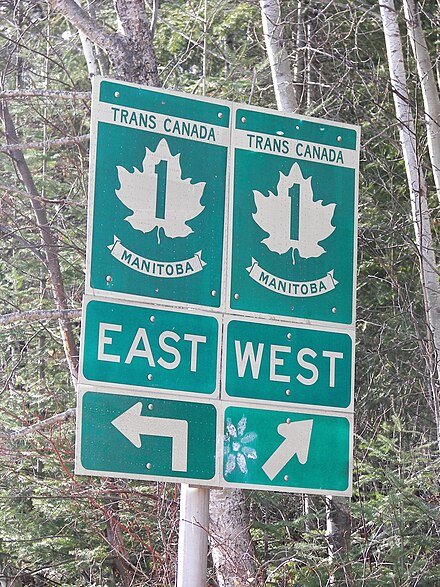
The history of automobile travel in Canada is inextricably linked to its southern neighbour, the United States. The Canadian automobile market had long been dominated by American companies, and driving culture is for the most part similar to that of the United States. Like the United States, Canada is a very car-dependent country, and most adult Canadians own cars. While the cities of Toronto, Montreal and Vancouver can be traversed using public transport, in most other places a car is almost essential due to the infrequency or even absence of public transport.
All road signs in Canada use metric units. Distance and speed are marked in kilometres and kilometres per hour. Most American cars have speedometers that display both units but if yours doesn't, keep in mind that one mile is about 1.6 km.
Like most countries, Canadians drive on the right in left-hand drive cars. Most rental cars are automatic transmission. Stick-shift (manual transmission) cars are rarely available unless you have made special arrangements in advance.
Although Canada is the second largest country in the world by land area after Russia, its population size is similar to that of Poland or Morocco. Outside the Windsor-Quebec corridor, distances are often vast and easy to underestimate; you may have to travel hundreds, or even thousands of kilometres before you can see the next trace of civilization. Motorists who wish to head off the beaten track need to be prepared for the elements, especially during Canada's notoriously harsh winters, and a satellite phone may be worthwhile investment if you are travelling to really remote areas.
Automobile clubs
The largest motoring group in Canada is the Canadian Automobile Association (CAA), which is comprised of numerous regional automobile clubs located throughout the country. Their services to members include roadside assistance and maps, a travel agency and discounts at various establishments. It is worth considering getting in touch with your local club before you set off on a road trip, as their assistance can be valuable in the event of something unexpected. The CAA also has reciprocal agreements with motoring groups in other countries, so some of their services may be available to travellers who are members of their local motoring group back home.
American Automobile Association (AAA) members may obtain the three CAA/AAA TourBooks (Western Canada, Ontario, Quebec-Atlantic) from their home club stateside.
Signage
The most noticeable difference for travellers may be the language of road signage; road signs are in English in most of the country, in French in Quebec, bilingual in English and French in New Brunswick and Ottawa, and bilingual in English and the local indigenous language (such as Inuktitut) in Nunavut. Aside from the language, the design of Canadian road signs is fairly consistent throughout the country and inspired from the United States. In Quebec, while road signs are solely in French, for the most part their meaning is obvious. Unlike the US, the majority of road signs in Canada are mainly icons rather than words.
Traffic laws
Driving laws in Canada are regulated at the provincial level, and rules of the road vary slightly from province to province. Differences in driving laws between the provinces are, for the most part, fairly minor.
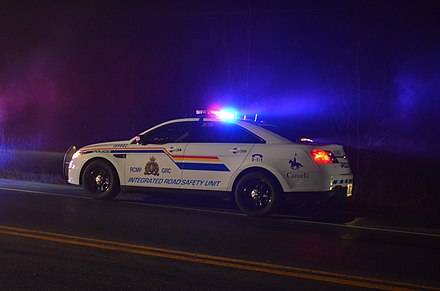
- Pedestrians have the right of way at intersections and crosswalks, provided they are not crossing against a signal.
- In Canada, you must always yield to a police car, fire truck, or ambulance when their emergency lights are flashing – if they are approaching from behind, you must pull to the right and stop.
- Private vehicles displaying flashing green lights in Ontario are volunteer fire fighters responding to an emergency, and should be yielded to as a matter of common sense.
- In many jurisdictions, including British Columbia, motorists are also required to slow down and move into a non-adjacent lane when passing a stopped emergency vehicle. Slowing to 60 km/h is the norm on a highway.
- The use of hand-held mobile devices while driving is banned in all provinces. Yukon is considering such a ban as well. Use of hands-free devices while driving is legal throughout Canada, although the Canadian Automobile Association is lobbying for such a ban. Some provinces such as Alberta expand upon this basic ban with Distracted Driving laws that also forbid other activities such as reading maps, doing makeup, and programming on-board GPS systems while driving.
- Some provinces have blood alcohol limits of 0.05%. The national Criminal Code limit is 0.08% – a foreign national exceeding this can expect to be fined heavily and deported – See respect below. Police in some provinces such as B.C. and Alberta may impound vehicles temporarily if the driver is between 0.05% and 0.08%, even though this doesn't violate national laws. Most provinces have "Checkstop" programs in place—these are randomly placed police checkpoints, usually set up at night, during which an officer will ask motorists of they've been drinking and gauge based upon their response and other factors whether to initiate further roadside sobriety or breathalyser tests. If you encounter one while driving—and assuming you haven't been drinking—in most cases you'll be let through after only a few seconds, though you may be asked to show your driver's licence (have your car rental agreement handy too, if it's requested).
- During winter, a flashing blue light usually identifies a snow removal vehicle in the six eastern provinces. Snow removal vehicles in the four western provinces use amber lights.
- In British Columbia, a (slow) flashing green light means the traffic light is green (you can go) but it is controlled by the pedestrian. The light will remain flashing green until a pedestrian pushes the button to cross the street; when you see a flashing green light, traffic coming towards you will also see a flashing green light. In Ontario, Quebec and Nova Scotia, a (fast) flashing green light indicates advanced turn, signalling the driver can make a left hand turn across oncoming traffic because oncoming traffic has a red light.
- Most provinces allow studded tires in the winter months (roughly October 15 to April 15; depends on the province), and some provinces allow studded tires all year; however, southern Ontario prohibits them year-round.
- In British Columbia, there are many roads, mainly in mountain passes, which require vehicles to be equipped with winter tires or carry chains from October 1 to April 30.
- In Quebec, winter tire use is mandatory for all taxis and passenger vehicles from December 15 to March 15. (This applies only to vehicles registered in the province; tourists driving into the province can use all season tires.)
Canadian winter tires have the mountain snowflake logo on the sidewall. Except for Quebec, Canadian rental (hire) cars do not routinely come with winter tires, but vehicles with winter tires are often available by request.
Licences
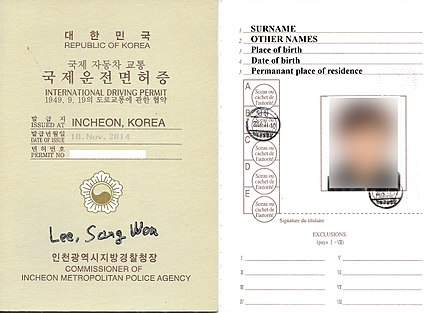
All drivers in Canada are required to have a valid licence. While the precise requirements vary from province to province, foreigners in Canada on tourist or business visas are generally allowed to drive with their foreign licence for the duration of their stay provided their licence is in English or French. Foreign licences in other languages must be accompanied by an International Driving Permit (IDP) or an official translation before they can be used.
Foreigners on longer term visas (e.g. work, student or permanent residence visas) are usually allowed to drive in Canada on their foreign licence for 3-6 months depending on their province of residence, after which they will have to obtain a Canadian licence from the province they reside in. Driver's licences are issued by the respective province and territory governments, and licensing laws vary from province to province. Most foreigners will be required to sit for theory and practical tests before they can obtain a Canadian licence, and the list of countries whose licence holders are exempted from testing requirements varies from province to province. As new Canadian drivers are usually required to go through a graduated licensing process, be sure to obtain an extract of your driving record from the issuing authority of your foreign licence before arriving in Canada, as many provinces require proof of your driving experience in order to exempt you from the full process.
All Canadian provinces require motorists to carry proof of liability insurance and the car's registration papers in the vehicle. If you are driving a rented car, the rental agreement will suffice for those.
Drunk driving
Canada has very strict laws on drunk driving, which is not just a traffic violation, but a very serious social taboo and a criminal offence in Canada. Under provincial highway traffic acts, the legal maximum blood alcohol level ranges from 0.04 in Saskatchewan to 0.08 in Alberta and Quebec (80 mg of alcohol in 100 mL of blood). Canada's federal Criminal Code allows criminal charges for anything above 0.08 and compels drivers to provide a breathalyser sample, with offenders being subject to fines and imprisonment. As a foreigner, a drunk driving conviction will almost certainly mean deportation, and a ban from re-entering Canada for at least 5 years. Even if you do not exceed the legal limit, you can still be charged for drunk driving if the police have reasonable grounds to believe that you are intoxicated (e.g. if you are caught driving erratically, or if you are involved in an accident).
Similarly, driving while under the influence of drugs is not tolerated in Canada, and is treated in the same way as drunk driving.
Traffic lights
in Canada, with the exception of the Island of Montreal, turning right on a red light is legal in Canada unless specifically prohibited by signage, provided you first come to a complete stop before entering the intersection, and yield to all cross traffic entering the intersection.
Speed limits
Speed limit signs in Canada are white rectangles with black text reading "MAXIMUM" with the speed below. In the absence of signage, the default speed limit on urban roads is 45 km/h in the Northwest Territories and 50 km/h (~30 mph) anywhere else. On rural highways, the default speed limit is 50 km/h in the Yukon, 80 km/h (~50 mph) in British Columbia and Ontario, 100 km/h (~60 mph) in Alberta, Newfoundland and Labrador, the Northwest Territories and Saskatchewan, and 90 km/h anywhere else. For those not used to driving in North America look out for playground and school signs as these are not automatically on your vision radar. Within playground and school zones, that is roads passing by one, the limit will be 30 km/h (~20 mph), although this may only be at particular times.
With the exception of a few jurisdictions in Western Canada, radar detectors are banned in most Canadian provinces. A few provinces (Quebec and Alberta in particular) are infamous for using photo radar to mass-generate tickets which are sent not to the driver but to the vehicle's owner, long after the alleged offence - effectively compromising the ability of the hapless motorist to defend themselves against the accusations. Red light cameras exist in a few large cities.
School buses
You are required to stop when you see a school bus picking up or letting off passengers regardless of which side of the road you are on. You are allowed to pass a stopped school bus from the opposite direction in a divided highway, except in British Columbia, Northwest Territories, Nova Scotia, Nunavut and Prince Edward Island.
Road networks
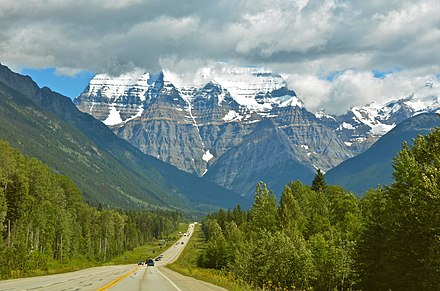
The road network in Canada is less developed than in the United States, largely owing to its lower population density. Freeways are ubiquitous around major cities and along the densely populated Windsor-Quebec corridor. Elsewhere, Canadian intercity highways are mostly either four-lane divided highways (2 in each direction) or two-lane undivided highways. The Trans-Canada Highway is Canada's national highway. It is a network of paved provincial highways connected to each other that span the length of the country from Victoria, British Columbia to St. John's, Newfoundland and Labrador. However, there are no bridges connecting Vancouver Island or Newfoundland to the mainland, meaning that you will have to cross the sea by car ferry. It is a freeway only for small parts of its length.
In the northern Arctic regions of the country, the road network is considerably less developed, with only a few roads linking the main population centres with major cities in the south. There are no roads into Nunavut from the other provinces and territories, and no roads connecting the different population centres within Nunavut; the only way to get there with your car would be to ship it over on a freighter in the summer months.
When driving through the expanses of Canada keep an eye out for changes of road colour ahead, even on numbered roads they can change from tarmacked to stone-gravel road surfaces without any warning. If you do hit one at speed, do not brake or turn quickly until you have your speed down.
City driving
With the exception of Vancouver and Winnipeg, most major Canadian cities have a system of urban freeways that allow rapid driving from the city centre to the suburbs. Driving habits in Canadian cities are similar to that in most other Western cities, and congestion can be expected during the morning and evening peak hours. Particularly in Toronto, Montreal and Vancouver, parking in the city centre can be hard to find and expensive, and you may want to consider leaving your car in a garage and using public transport instead.
Logging roads
If you go a little off the main roads, be careful on roads used by logging trucks. These trucks require the full road and tend to drive very fast. Be aware of milepost marking on the sides of the road, by which other road users will be transmitting their position on CB. Also keep a look out for dust clouds, and pull over to the side of the road when you do see them.
Toll roads

Toll roads are less common in Canada than in the United States; a difference which is more than made up for by Canada's high fuel taxes. There are a few notable exceptions. On a per-km basis, Highway 407, which bypasses Toronto by going north into York Region, is one of the most expensive in North America (though it's a godsend for long-distance travellers through the Toronto area who are keen on avoiding the ever-present, sometimes hours-long traffic snarls on Highway 401). Nova Scotia operates one toll on the Trans-Canada Highway at the Cobequid Pass, despite imposing fuel taxes which are a nickel a litre higher than neighbouring New Brunswick. Access to islands such as Prince Edward Island, Newfoundland or Vancouver Island by car will inevitably incur ferry or bridge tolls.
Although not strictly toll roads, if you drive through a national park, for example Highway 1 Trans-Canada Highway through Banff National Park, you will have to pay the park fee if you intend to stop or park your vehicle within the park boundaries.
Fuel
Fuel in Canada is sold by the litre; there are 4.5 litres in an imperial gallon, or 3.78 litres in a U.S. one. Fuel taxes, while not as high as those in Europe, are painful by US standards. Montreal Island, Quebec City and Vancouver tax fuel heavily in an attempt to force local commuters onto public transit. Fuel in remote areas (such as Labrador) tends to be the most expensive in the nation.
In some remote locations (such as the Trans-Labrador Highway or the James Bay Road) the distance to the next filling station may be more than 400 km (250 miles). Don't set out without a full tank (and preferably a spare can), as well as enough supplies to survive stranded for hours if the vehicle breaks down.
Distances
Do not underestimate distances between towns. It is easy to forget when you arrive by plane in a major Canadian city with a gas station on every corner that once you get out into the country you can drive for a number of hours without coming across a large settlement. Make sure you have a full tank of fuel and drinking water before a journey of any length.
Stay safe
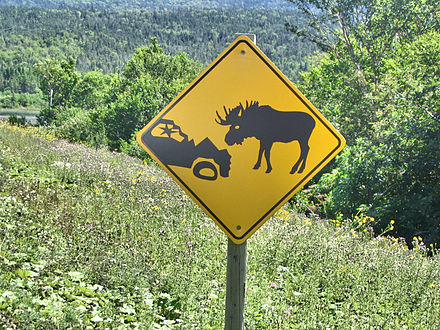
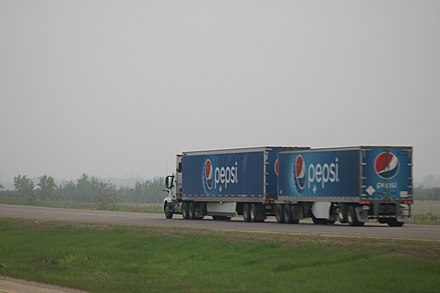
One of the reasons for visiting Canada is for the great outdoors and the wildlife. Be aware however that the wildlife does not always stay in the woods; keep an eye out for bears, deer, elk and mountain goats on the road. A moose on the highway is a Newfoundland stop sign and animal collisions can be deadly.
Winter driving can be dangerous due to snow and ice. Peak afternoon traffic travels in darkness for most Canadians in winter; blowing snow further lowers visibility on slippery roads during storms. A few remote communities rely on ice roads across frozen lakes or rivers; under the wrong conditions, taking a vehicle onto the open ice can be suicide. In mountainous areas in winter, roads may sometimes be closed due to avalanche conditions.
Be careful driving near heavy trucks, particularly in the Prairies. Keep an adequate distance from them, watch for spray that can damage your windshield, and pass them with care. In the Prairies and rarely in other provinces, there are also a lot of double semi-trailers – much like Australia's road trains – on the highways; these can be at the form of B-trains or two semi-trailers, and can reach in length.
Take extra care to look out for pedestrians, Canadians expect people to be polite and expect cars to stop for them even when they step out into the road unexpectedly without looking.